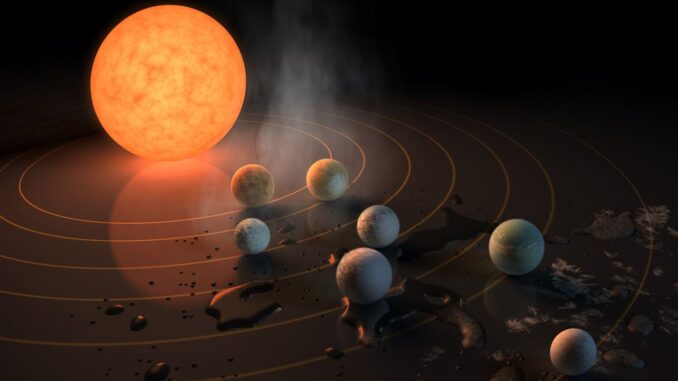
In News
Astronomers discovered a new six planet solar system orbiting the star HD158259, 88 light-years away from the Earth.
In-Detail
- Scientists discovered a six planet solar system consisting of a “super-earth” and five mini Neptunes and an orbit around the star HD1528259 which is about the same mass but little larger than the Sun.
- This orbital formation can help in understanding the gravitational influence and the formation of the planets.
- Researchers from the University of Geneva in Switzerland mapped the orbital movements of the planets by using the SOPHIE spectrograph and the TESS exoplanet-hunting space telescope.
- Researchers monitored for seven years and discovered that the six planets were in perfect orbital resonance.
Orbital Resonance
- Orbital Resonance is a term used to understand how the orbits of the two planets are connected and how the two bodies exert gravitational influence on each other or sync together.
- The best example of this phenomenon is Pluto and Neptune in our solar system.
- These two bodies have 2:3 orbital resonance that means for every two laps Pluto makes around the Sun, Neptune makes three.
- Researchers found that the planet closest to its star HD 158259 is in 3:2 resonance and with a period ratio of 1.5.
- This exoplanet can help researchers understand the planetary migration and the events that occur after the formation of the planets. It can also help to understand the early days of the universe.
- The six planets solar system also displays exceptional regular spacing which helped astronomers to gather information on how the system may have formed in the Draco Constellation.
Super-Earth
- A Super Earth is any planet similar to the earth but with greater size. Its surface is surrounded by a gas envelope similar to Uranus and does not imply anything about the surface conditions or habitability.
- With telescope technology, most super Earths are found near M-class Red Dwarf stars which are smaller than our sun or G-class stars similar to the sun.
Goldilocks Zones
- Goldilocks zones are habitable zones, an area around the stars where it is not too hot and too cold for liquid water to exist on the surface of surrounding planets.
- An example of the Goldilocks zone is Earth.
- Astronomers look for planets in the Goldilocks zone in the hope of finding a planet similar to earth and with liquid water.
- A Super Earth may or may not be in the Goldilocks zone.
TESS Exoplanet-Hunting Space Telescope
- The Transiting Exoplanet Survey Satellite (TESS) is used in the search for planets outside the solar system including those that support life.
- TESS was launched on 18th April 2018, aboard a SpaceX Falcon 9 rocket.
- The mission approach of TESS is to survey the entire sky within two years.
- TESS is expected to find 20,000 Exoplanets in its two-year prime mission.
What is EXOPLANET?
- An Exoplanet is an extrasolar planet, located outside the solar systems.
- Planets that revolve around the stars are called exoplanets. They are hidden by the bright glare of the stars. So it is hard to see them directly with a telescope.
- NASA Kepler’s Space Telescope discovered many exoplanets.
- By April 2, 2020, there are 4,241confirmed exoplanets in 3,139 systems.
- The nearest exoplanet is Proxima Centauri b, located 4.2 light-years from the earth.
- The potentially habitable exoplanet with the highest Earth similarity is Teegarden b.

Leave a Reply
You must be logged in to post a comment.